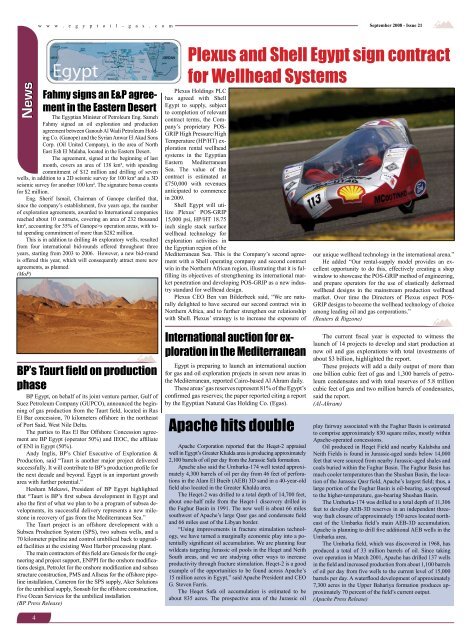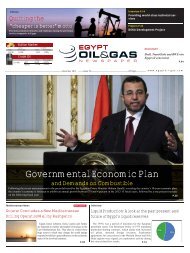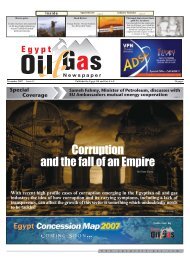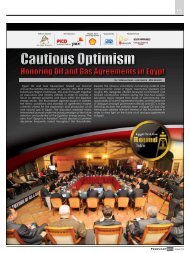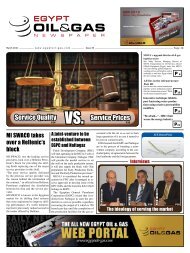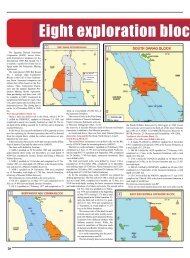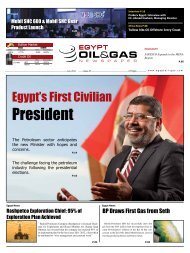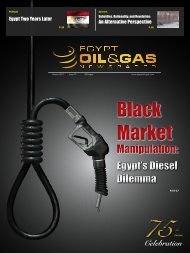EOG Newspaper September 08 Issue - Egypt Oil & Gas
EOG Newspaper September 08 Issue - Egypt Oil & Gas
EOG Newspaper September 08 Issue - Egypt Oil & Gas
Create successful ePaper yourself
Turn your PDF publications into a flip-book with our unique Google optimized e-Paper software.
<strong>September</strong> 20<strong>08</strong> - <strong>Issue</strong> 21<br />
Fahmy signs an E&P agreement<br />
in the Eastern Desert<br />
The <strong>Egypt</strong>ian Minister of Petroleum Eng. Sameh<br />
Fahmy signed an oil exploration and production<br />
agreement between Ganoub Al Wadi Petroleum Holding<br />
Co. (Ganope) and the Syrian Anwar El Akad Sons<br />
Corp. (<strong>Oil</strong> United Company), in the area of North<br />
East Esh El Malaha, located in the Eastern Desert.<br />
The agreement, signed at the beginning of last<br />
month, covers an area of 138 km², with spending<br />
commitment of $12 million and drilling of seven<br />
wells, in addition to a 2D seismic survey for 100 km² and a 3D<br />
seismic survey for another 100 km². The signature bonus counts<br />
for $2 million.<br />
Eng. Sherif Ismail, Chairman of Ganope clarified that,<br />
since the company’s establishment, five years ago, the number<br />
of exploration agreements, awarded to International companies<br />
reached about 10 contracts, covering an area of 232 thousand<br />
km², accounting for 35% of Ganope>s operation areas, with total<br />
spending commitment of more than $282 million.<br />
This is in addition to drilling 46 exploratory wells, resulted<br />
from four international bid-rounds offered throughout three<br />
years, starting from 2003 to 2006. However, a new bid-round<br />
is offered this year, which will consequently attract more new<br />
agreements, as planned.<br />
(MoP)<br />
Plexus and Shell <strong>Egypt</strong> sign contract<br />
for Wellhead Systems<br />
Plexus Holdings PLC<br />
has agreed with Shell<br />
<strong>Egypt</strong> to supply, subject<br />
to completion of relevant<br />
contract terms, the Company’s<br />
proprietary POS-<br />
GRIP High Pressure/High<br />
Temperature (HP/HT) exploration<br />
rental wellhead<br />
systems in the <strong>Egypt</strong>ian<br />
Eastern Mediterranean<br />
Sea. The value of the<br />
contract is estimated at<br />
£750,000 with revenues<br />
anticipated to commence<br />
in 2009.<br />
Shell <strong>Egypt</strong> will utilize<br />
Plexus’ POS-GRIP<br />
15,000 psi, HP/HT 18.75<br />
inch single stack surface<br />
wellhead technology for<br />
exploration activities in<br />
the <strong>Egypt</strong>ian region of the<br />
Mediterranean Sea. This is the Company’s second agreement<br />
with a Shell operating company and second contract<br />
win in the Northern African region, illustrating that it is fulfilling<br />
its objectives of strengthening its international market<br />
penetration and developing POS-GRIP as a new industry<br />
standard for wellhead design.<br />
Plexus CEO Ben van Bilderbeek said, “We are naturally<br />
delighted to have secured our second contract win in<br />
Northern Africa, and to further strengthen our relationship<br />
with Shell. Plexus’ strategy is to increase the exposure of<br />
our unique wellhead technology in the international arena.”<br />
He added “Our rental-supply model provides an excellent<br />
opportunity to do this, effectively creating a shop<br />
window to showcase the POS-GRIP method of engineering,<br />
and prepare operators for the use of elastically deformed<br />
wellhead designs in the mainstream production wellhead<br />
market. Over time the Directors of Plexus expect POS-<br />
GRIP designs to become the wellhead technology of choice<br />
among leading oil and gas corporations.”<br />
(Reuters & Rigzone)<br />
BP’s Taurt field on production<br />
phase<br />
BP <strong>Egypt</strong>, on behalf of its joint venture partner, Gulf of<br />
Suez Petroleum Company (GUPCO), announced the beginning<br />
of gas production from the Taurt field, located in Ras<br />
El Bar concession, 70 kilometers offshore in the northeast<br />
of Port Said, West Nile Delta.<br />
The parties to Ras El Bar Offshore Concession agreement<br />
are BP <strong>Egypt</strong> (operator 50%) and IEOC, the affiliate<br />
of ENI in <strong>Egypt</strong> (50%).<br />
Andy Inglis, BP’s Chief Executive of Exploration &<br />
Production, said “Taurt is another major project delivered<br />
successfully. It will contribute to BP’s production profile for<br />
the next decade and beyond. <strong>Egypt</strong> is an important growth<br />
area with further potential.”<br />
Hesham Mekawi, President of BP <strong>Egypt</strong> highlighted<br />
that “Taurt is BP’s first subsea development in <strong>Egypt</strong> and<br />
also the first of what we plan to be a program of subsea developments,<br />
its successful delivery represents a new milestone<br />
in recovery of gas from the Mediterranean Sea.”<br />
The Taurt project is an offshore development with a<br />
Subsea Production System (SPS), two subsea wells, and a<br />
70 kilometer pipeline and control umbilical back to upgraded<br />
facilities at the existing West Harbor processing plant.<br />
The main contractors of this field are Genesis for the engineering<br />
and project support, ENPPI for the onshore modifications<br />
design, PetroJet for the onshore modification and subsea<br />
structure construction, PMS and Allseas for the offshore pipeline<br />
installation, Cameron for the SPS supply, Aker Solutions<br />
for the umbilical supply, Sonsub for the offshore construction,<br />
Five Ocean Services for the umbilical installation.<br />
(BP Press Release)<br />
International auction for exploration<br />
in the Mediterranean<br />
<strong>Egypt</strong> is preparing to launch an international auction<br />
for gas and oil exploration projects in seven new areas in<br />
the Mediterranean, reported Cairo-based Al Ahram daily.<br />
These areas’ gas reserves represent 81% of the <strong>Egypt</strong>’s<br />
confirmed gas reserves; the paper reported citing a report<br />
by the <strong>Egypt</strong>ian Natural <strong>Gas</strong> Holding Co. (Egas).<br />
Apache hits double<br />
Apache Corporation reported that the Heqet-2 appraisal<br />
well in <strong>Egypt</strong>’s Greater Khalda area is producing approximately<br />
2,100 barrels of oil per day from the Jurassic Safa formation.<br />
Apache also said the Umbarka-174 well tested approximately<br />
4,300 barrels of oil per day from 46 feet of perforations<br />
in the Alam El Bueib (AEB) 3D sand in a 40-year-old<br />
field also located in the Greater Khalda area.<br />
The Heqet-2 was drilled to a total depth of 14,700 feet,<br />
about one-half mile from the Heqet-1 discovery drilled in<br />
the Faghur Basin in 1991. The new well is about 66 miles<br />
southwest of Apache’s large Qasr gas and condensate field<br />
and 66 miles east of the Libyan border.<br />
“Using improvements in fracture stimulation technology,<br />
we have turned a marginally economic play into a potentially<br />
significant oil accumulation. We are planning four<br />
wildcats targeting Jurassic oil pools in the Heqet and Neith<br />
South areas, and we are studying other ways to increase<br />
productivity through fracture stimulation. Heqet-2 is a good<br />
example of the opportunities to be found across Apache’s<br />
15 million acres in <strong>Egypt</strong>,” said Apache President and CEO<br />
G. Steven Farris.<br />
The Heqet Safa oil accumulation is estimated to be<br />
about 835 acres. The prospective area of the Jurassic oil<br />
The current fiscal year is expected to witness the<br />
launch of 14 projects to develop and start production at<br />
new oil and gas explorations with total investments of<br />
about $3 billion, highlighted the report.<br />
These projects will add a daily output of more than<br />
one billion cubic feet of gas and 1,300 barrels of petroleum<br />
condensates and with total reserves of 5.8 trillion<br />
cubic feet of gas and two million barrels of condensates,<br />
said the report.<br />
(Al-Ahram)<br />
play fairway associated with the Faghur Basin is estimated<br />
to comprise approximately 830 square miles, mostly within<br />
Apache-operated concessions.<br />
<strong>Oil</strong> produced in Heqet Field and nearby Kalabsha and<br />
Neith Fields is found in Jurassic-aged sands below 14,000<br />
feet that were sourced from nearby Jurassic-aged shales and<br />
coals buried within the Faghur Basin. The Faghur Basin has<br />
much cooler temperatures than the Shushan Basin, the location<br />
of the Jurassic Qasr field, Apache’s largest field; thus, a<br />
large portion of the Faghur Basin is oil-bearing, as opposed<br />
to the higher-temperature, gas-bearing Shushan Basin.<br />
The Umbarka-174 was drilled to a total depth of 11,306<br />
feet to develop AEB-3D reserves in an independent threeway<br />
fault closure of approximately 150 acres located northeast<br />
of the Umbarka field’s main AEB-3D accumulation.<br />
Apache is planning to drill five additional AEB wells in the<br />
Umbarka area.<br />
The Umbarka field, which was discovered in 1968, has<br />
produced a total of 33 million barrels of oil. Since taking<br />
over operation in March 2001, Apache has drilled 137 wells<br />
in the field and increased production from about 1,100 barrels<br />
of oil per day from five wells to the current level of 15,000<br />
barrels per day. A waterflood development of approximately<br />
7,300 acres in the Upper Bahariya formation produces approximately<br />
70 percent of the field’s current output.<br />
(Apache Press Release)


